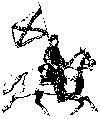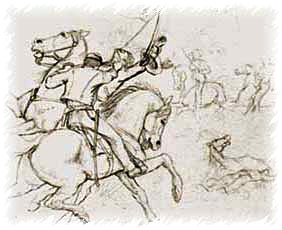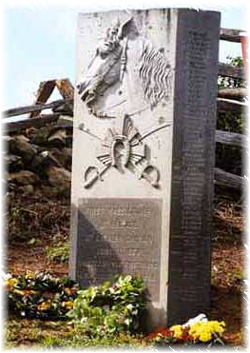
See also:
1st Massachusetts Cavalry Monument Dedication
In 1880 the survivors of the 1st Massachusetts Cavalry, who lost more than 100 men at this site, erected a commemorative monument on this curve to mark the spot where the heaviest fighting took place. The owners of the Furr house, whose descendants still own the house, donated the land.
This is the only monument dedicated to Union forces that exists in Loudoun County today.
June 1863 - a prelude to Gettysburg.
 General Lee was marching his Confederate forces up through the Shenandoah Valley in preparation for a northern invasion. He had given General Jeb Stuart the task of preventing the Union forces from discovering the Confederate intentions. It was therefore imperative that the Union troops not control either the Little River Turnpike, now Route 50, or the Snickersville Turnpike - the two roads over the mountain passes leading to the Shenandoah Valley.
General Lee was marching his Confederate forces up through the Shenandoah Valley in preparation for a northern invasion. He had given General Jeb Stuart the task of preventing the Union forces from discovering the Confederate intentions. It was therefore imperative that the Union troops not control either the Little River Turnpike, now Route 50, or the Snickersville Turnpike - the two roads over the mountain passes leading to the Shenandoah Valley. Stuart had orders to delay the greater Union forces until General Lee had moved through the valley and had invaded Maryland.
The battle for the Snickersville Turnpike was fierce. Today that curve in the road is peaceful and quiet. Imagine the scene in 1863 when the Snickersville Turnpike was a macadamized road and was terribly dusty with white limestone dust.
 It was a hot day. There had been fighting in this area all day and dead horses and men lay in the fields near the turnpike. There was a stone wall with a steep drop off on the south side of the road and on the other side was a split rail fence. The narrow, confining sunken road approached a blind curve. Just behind this blind curve was a stone wall, and sharpshooters from the 2nd and 3rd Virginia Cavalry were concealed there.
It was a hot day. There had been fighting in this area all day and dead horses and men lay in the fields near the turnpike. There was a stone wall with a steep drop off on the south side of the road and on the other side was a split rail fence. The narrow, confining sunken road approached a blind curve. Just behind this blind curve was a stone wall, and sharpshooters from the 2nd and 3rd Virginia Cavalry were concealed there. On the hill behind the stone wall was a cannon. None of this could be seen by the Union troopers of the 1st Massachusetts Cavalry approaching from Aldie four abreast on the road. They would not realize the ambush until they entered the bend, and then it would be too late.
In his book "The Cavalry Battles of Aldie, Middleburg, and Upperville", Bob O'Neill describes the scene:
"The narrow bend in the road quickly became a dusty, confused killing ground from which there was little chance of escape. Men were punched out of their saddles by sharpshooters who could practically touch their targets. Once down in the road the wounded endured a greater horror as terrified and wounded horses plunged and reared, trampling those underneath… Hemmed in by the deep cut as well as the walls and fences and pressed by their comrades behind them the Yankees could not avoid the deadly fire that dropped them by the score."
Confederate Colonel Tom Munford in his official account of the battle reported that on the Snickersville Turnpike there were more Yankees killed "in the same space of ground in any fight - or any battlefield in Virginia that I have ever been over."
A Northern surgeon said that it was "by far the most bloody cavalry battle of the war." This then is hallowed ground made sacred by the blood of the men that died there on that hot June day in 1863 and in 1994 this hallowed ground was threatened.
Along the Snickersville Turnpike in the spring of 1994 surveyor's stakes appeared . Alarmed citizens rapidly inquired of The Virginia Department Of Transportation (VDOT) the meaning of these stakes and were told that VDOT was going to "improve" the Snickersville Turnpike. This "improvement" entailed widening the road to 22 paved feet with 6-foot gravel shoulders and bypassing that historic curve in the road because it was deemed to be a "safety issue".
All of the historic stone walls and mature trees would have been obliterated as well as the historic significance of the road. The citizens quickly rallied to oppose this project and the Snickersville Turnpike Association was formed.
Although this organization was told that VDOT could not stop the project because it had progressed too far, the citizens paid no attention to these words and prepared to do another battle for the Snickersville Turnpike. The site of the 1st Massachusetts monument became a focal point for that battle.
In 1995, Dr. Joe Ciano, a member of a Civil War reenactment group near Boston, Massachusetts contacted the Snickersville Turnpike Association with his concerns. His group was the 1st Massachusetts and like many of the original 1st Mass Cavalry members he was a graduate of Harvard.
Word of VDOT's plans to bypass this historic place in the road had reached Massachusetts and because historic places belong to all citizens, those Northerners were concerned that another piece of history was to be lost to "improvement". The Snickersville Turnpike Association decided to hold "A Rally For The Road".
The re-enactors from Massachusetts loaded their horses and gear into their trailers and came to Virginia to put on a public demonstration of what happened on that section of the road on that hot June day in 1863. The citizens gathered at the monument to show their support for preserving this sacred place. The 1st Mass Cavalry rode down the road four abreast just like in 1863 while re-enactor sharpshooters stood behind the same stone wall that sharpshooters stood behind in 1863.
As it was in 1863, the day was hot. A noted historian, Bob O'Neill, narrated the battle while the 1st Mass came in view. Then there were speeches. Citizens who had never been aware of the importance of this place went away that day with a renewed sense of dedication to preserving it.
The citizens were successful. VDOT agreed to abandon their ‘improvement' plans and there was an agreement reached that would make the road 19' wide. In the meantime the Snickersville Turnpike Association had applied for federal funds under the Intermodal Surface Transportation Efficiency Act (ISTEA) to restore the area of the 1st Massachusetts Cavalry monument.
It was planned to cut down the dead trees and brush that had grown up nearly obliterating the monument and to plant native shrubs and trees. The stone wall where the sharpshooters had been concealed was to be rebuilt and a split rail fence was to be constructed on the north side of the road. A pull off so that a car could safely stop to see the monument was also planned.
In 1995 ISTEA awarded the Snickersville Turnpike Association $ 56,000 to restore this area and a section of the pike further west in the VDOT area of a one-lane bridge that had been "improved" by VDOT . The Snickersville Turnpike Association was successful in raising the $14,000 in matching funds.
On February 15, 2001 the Commonwealth Transportation Board of Virginia awarded the contract to Loudoun County and the work to restore this area was begun.
 Today, when you drive down the Snickersville Turnpike stop for a moment at the monument. You are standing in the exact spot where so many men sacrificed their lives to preserve the United States of America. Engraved in the granite monument are their names. You can look out across the same fields toward the Bull Run Mountains and see the same view as those men saw in 1863.
Today, when you drive down the Snickersville Turnpike stop for a moment at the monument. You are standing in the exact spot where so many men sacrificed their lives to preserve the United States of America. Engraved in the granite monument are their names. You can look out across the same fields toward the Bull Run Mountains and see the same view as those men saw in 1863. Nothing has changed. There is no super highway across those fields. It is mostly quiet in this place with only the chirp of a bird to be heard. Yet somewhere in the memory of the rocks, and trees and earth there is the jingle of bits and the creak of saddle leather and the sounds of hoof beats on that dusty road those many years ago.
Maybe, if you listen carefully enough, you will hear them.

















| info@snickersvilleturnpike.org